When monitoring trends, sociologists and marketeers like to talk about "early adopters". They mean the people who first have the courage and the nuance to start a trend, or be the first to be seen to be doing something new or otherwise unusual.
At the dawn of the motoring age the aristocracy were early adopters of private motor vehicle ownership; paving the way for motorisation for the masses to come later. In technology, those of you who brought an Apple iPod more than 9 years ago were early adopters of a new way of listening to music, before we all started doing it.
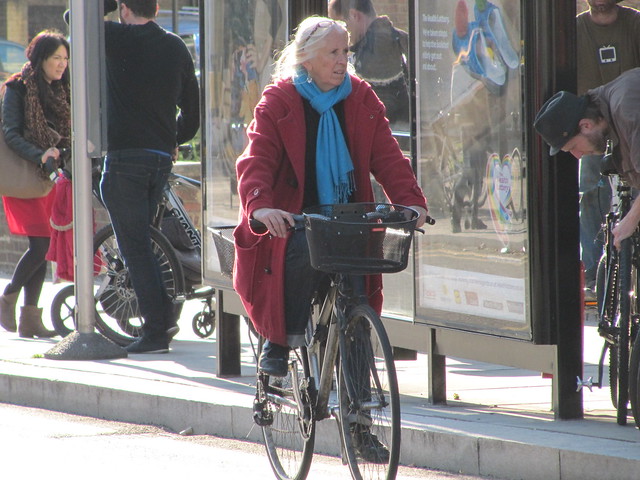
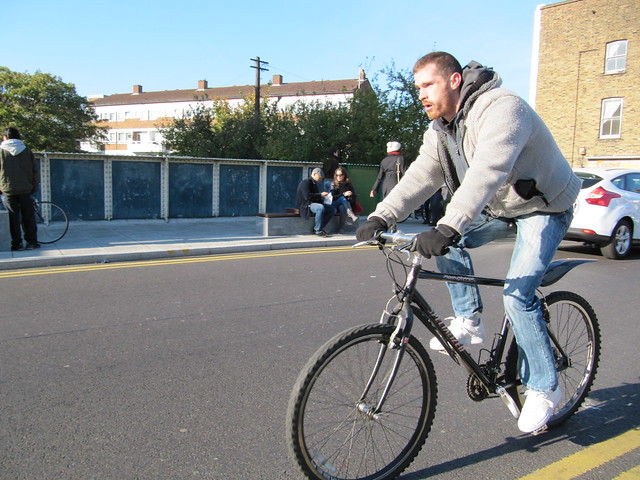
I have no evidence to back me up, and I'm highly aware that the experiences I am about to discuss are limited only to one small corner of Hackney, near to where I live - but around Broadway Market I believe there is a clear pattern of people using bikes passing the "early adopter" stage and moving in to the mainstream. 6 or 7 years ago there were still lots of cyclists around Broadway Market, but they seemed to me to be primarily male, more focused on "gear", or indeed fixed wheel riders. The fixed wheel "craze" really took off amongst the young art and design creative community in the East End and had a large scene to back it up and help to nurture it (such as specialist shops, bike polo groups etc), and long may it continue. But as Mikael Colville Anderson of Copenhagenize fame describes in his presentation "Behavioural changes for urban cycling", the fixed wheel craze is sub-cultural (that is to say only appeals to a limited group of people) whereas when something is mainstream ("cultural"?) it appeals to all sorts of different everyday and ordinary people, and indeed is accessible to all.
Now, don't get me wrong, I rather like fixed wheel bikes, and I have no more beef with people who want to tear up the city in a single speed alley cat than I do with someone who wants to pootle to work on a Dutch upright bike.
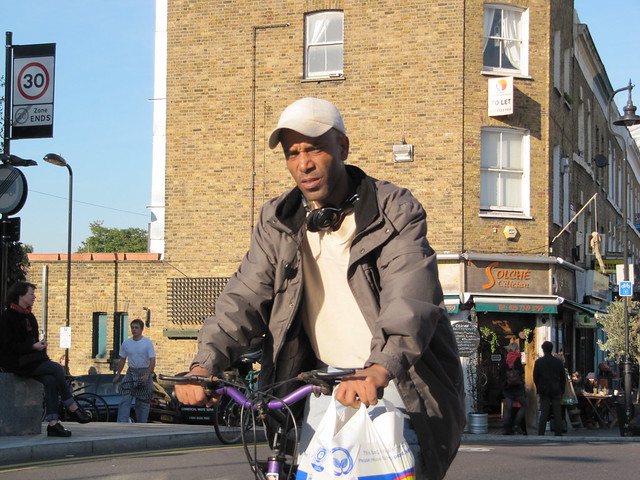
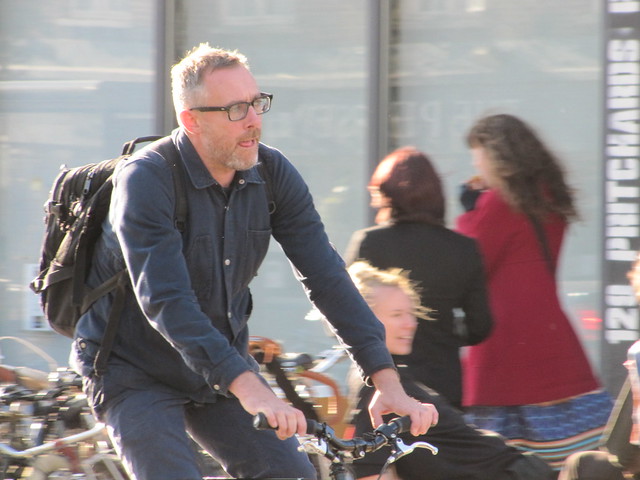
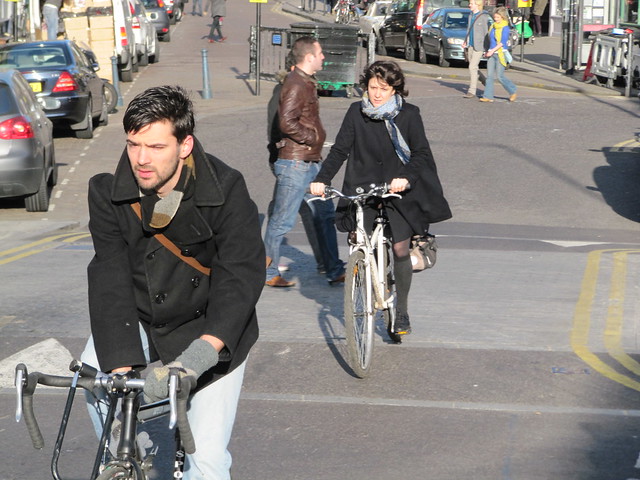
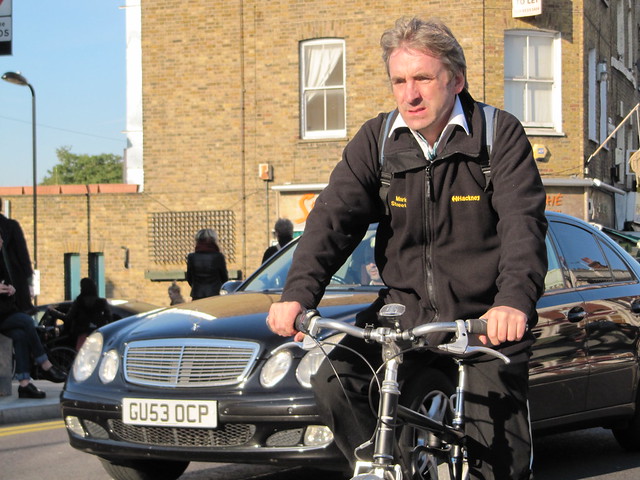
But I am certain that we've passed the narrow-cast "craze" stage of cycling around Broadway Market and moved on to the "everyday and ordinary". That is to say, the "sub-cultural" riders would cycle regardless of whether it was a mainstream activity or not, but perhaps the prevalence of "sub-cultural" riders in recent years has helped to encourage others to become early adopters and help to mainstream cycling. I've talked before about Hackney and how the organic grid of cycle routes and different types of infrastructure have helped to create conditions which are inviting for cycling, but I wonder what the key factor is in helping to make cycling here seem so much more mainstream than elsewhere in London. Note in my pictures the age range and diversity of the cyclists portrayed. Note the lack of helmets, high visability gear and cycle-specific clothing. I have my own ideas as to what I think are driving the move from early adopters to mainstream cyclists in my neighbourhood (regular readers won't be surprised to hear I think that design and planning have a lot to do with it) but what do you think? Is cycling still a narrow-cast reserve of the few where you are, or, like Broadway Market, is it becoming everyday and ordinary? If you currently cycle only in cycle-specific gear, helmets and high-vis what would convince you to change to a more leisurely European style of riding?
As always, I'm keen to hear your thoughts!
Share |
At the dawn of the motoring age the aristocracy were early adopters of private motor vehicle ownership; paving the way for motorisation for the masses to come later. In technology, those of you who brought an Apple iPod more than 9 years ago were early adopters of a new way of listening to music, before we all started doing it.


I have no evidence to back me up, and I'm highly aware that the experiences I am about to discuss are limited only to one small corner of Hackney, near to where I live - but around Broadway Market I believe there is a clear pattern of people using bikes passing the "early adopter" stage and moving in to the mainstream. 6 or 7 years ago there were still lots of cyclists around Broadway Market, but they seemed to me to be primarily male, more focused on "gear", or indeed fixed wheel riders. The fixed wheel "craze" really took off amongst the young art and design creative community in the East End and had a large scene to back it up and help to nurture it (such as specialist shops, bike polo groups etc), and long may it continue. But as Mikael Colville Anderson of Copenhagenize fame describes in his presentation "Behavioural changes for urban cycling", the fixed wheel craze is sub-cultural (that is to say only appeals to a limited group of people) whereas when something is mainstream ("cultural"?) it appeals to all sorts of different everyday and ordinary people, and indeed is accessible to all.
Now, don't get me wrong, I rather like fixed wheel bikes, and I have no more beef with people who want to tear up the city in a single speed alley cat than I do with someone who wants to pootle to work on a Dutch upright bike.




But I am certain that we've passed the narrow-cast "craze" stage of cycling around Broadway Market and moved on to the "everyday and ordinary". That is to say, the "sub-cultural" riders would cycle regardless of whether it was a mainstream activity or not, but perhaps the prevalence of "sub-cultural" riders in recent years has helped to encourage others to become early adopters and help to mainstream cycling. I've talked before about Hackney and how the organic grid of cycle routes and different types of infrastructure have helped to create conditions which are inviting for cycling, but I wonder what the key factor is in helping to make cycling here seem so much more mainstream than elsewhere in London. Note in my pictures the age range and diversity of the cyclists portrayed. Note the lack of helmets, high visability gear and cycle-specific clothing. I have my own ideas as to what I think are driving the move from early adopters to mainstream cyclists in my neighbourhood (regular readers won't be surprised to hear I think that design and planning have a lot to do with it) but what do you think? Is cycling still a narrow-cast reserve of the few where you are, or, like Broadway Market, is it becoming everyday and ordinary? If you currently cycle only in cycle-specific gear, helmets and high-vis what would convince you to change to a more leisurely European style of riding?
As always, I'm keen to hear your thoughts!
Share |
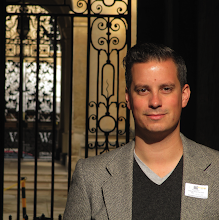



17 comments:
I don't often stray as far as Hackney but when I did - to scout out a route for a friend who wanted to cycle commute from Waterloo to Kingsland Rd, and then escort her on her first try, on a sunny Spring Sunday afternoon - I was struck both by the relative quality of the infrastructure (quite a contrast as you cross the border from the City) and by the vibrant outdoor culture along Columbus and Broadway markets, London Fields etc. There were bikes everywhere. Very few in fact were Fixies, and most were not particularly smart - a mix of old and new, urban utility and MTB/hybrid, but just a steed.
I observe cycle culture both where I work, in the western half of the City and eastern half of Westminster, and where I live, where Surrey, Sussex and Hampshire meet.
In the City, I guess we are somewhere between subculture and culture. There are loads of people out on bikes, but probably most are dressed-up for it, helmeted, and "vehicular". With the exception of one group, most are in the saddle in peak hours only - either they stay in their offices all day, or if they travel to meetings they mainly use minicabs and taxis or perhaps bus and tube, because now they are wearing clothes which don't work for the type of bike or the style of cycling they have adopted.
Exceptions are couriers, who are obviously active pretty much around the clock - the City depends even now on printed and signed documents for final legal agreements so these documents have to be ferried around. Another exception of course is the legion of cycle hire users who empty the docking stations outside the mainline stations, and the Bromptonauts (like me) who spill off a typical Waterloo arrival more than a dozen at a time.
Down in SW Surrey, I can't say there is any perceivable cycle culture, or even sub-culture, at all. Sure, Hindhead Common is overrun at weekends with guys (mainly guys) on their hardtail XCs or doing downhills on full-sus MTBs like they were skiing. The railway station cycle parking, which has at least doubled in size in recent years, is full to capacity every weekday.
Otherwise it is rare to see a bicycle on a road, and when I ride into town to the shops, I will be lucky to see more than one or two other bikes chained to the meagre choice of Sheffield Stands which Surrey CC has in their wisdom and generosity provided.
Things may be looking up though. All the residential streets around the station are now choked solid with parked cars, many of which arrive well before the paying car parks have filled up although those are now way too small to accomodate the demand. Residents have divided into two camps, one of which is campaigning for parking controls and another which is whining noisily about Surrey CC's evident resolution to act. the latter group, as you might have guessed, are those who actually live in the town but can't be arsed to walk or cycle the mile or less from their homes to the station or town centre and expet to be able to drive that distance and park for free.
When I wrote to my local county councillor to let him know that there was at least one person out there on his side, I suggested that the County should take a good look at cycle parking provision at both station and shops, and amazingly, they have already started to investigate the potential for increasing it.
Thanks Paul, for sharing your experience and perception of other cyclists where you live and work. It sounds as though Surry council might actually do something postivie where you live, soon. I'm always astonished that railway operating companies, or indeed Network Rail, don't lobby to make their stations easier and safer to ride to and from: people on bikes could be a huge after rail market, and it is much easier and cheaper to meet their demands than trying to squeeze in more station car parks.
If you'd asked me 5 years ago if I thought that couriers had a future I'd have said they were finished as paper evaporated from offices. But, like you, there are key things that I do in the day job that still have to be put down on paper, signed, sealed and delivered and the bicycle courier is still the quickest and often cheapest way to get this done. Long may it continue as they form a vital part of the cycling "scene" in the city!
I commute from South Woodford through Hackney into Soho most days. I only cycle in specific gear. Mainly because of distance and time. There is a noticeable increase in cyclists as you hit the Hackney area. I wonder if it's about the people living AND working in the area (you reference the growing creative industry/community in the east and expanding outwards). Are there any other areas where home and work are in such close proximity - Canary Wharf perhaps? Or are most other cyclists like Paul and myself who have some distance between work and home.
That's a very good point Tom. Indeed, it's noticeable that there are different "types" of cyclists at different times of day. In the AM and PM peaks of course you get lots of commuter cyclists and lots of people who have to travel quite a long way, hence the gear. During the day, as you point out, local people might be making shorter trips and therefore being a bit more everyday and ordinary. Also, the east end creative scene is pretty image conscious as well, could fashion have a hand in it all I wonder?
I've noticed a gradual increase in "normal" cyclists around where I live, in Southwark. There are definitely more people in normal clothes, riding a "back of the shed" bike, to do errands and get about. Outside of the city, I think a lot of people are realising that bikes are a cheaper way to travel, as the cost of petrol and public transport rises, and using a bike for at least some of your journeys makes a great deal of financial sense if you're on a lower income. I really hope that as it becomes a more mainstream activity, councils start including proper bike provision in their planning.
@Liz I wonder if the economic benefits, which are all too apparent, along with all the other people already riding, have been enough to normalise cycling in some people's minds and enough to encourage them in turn to try cycling?
Like you, I hope that Councils and transport planners start to think more seriously about providing for people on bikes, which I think will really help to make it a much more mainstream activity.
When I first started commuting by bike in London, some 15 years ago it really did feel like only the truly committed did it.
I took a break for a few years, but when I got back into it about 5 years ago I was really surprised by the increase in numbers, but even that jump feels like nothing compared to the increase I've perceived in last 18-24 months.
There's been what I can only describe as a "filling in". Historically I would characterise London cyclists as the committed and the desperate. People with a lot of gear and nice bikes and frankly speaking, people who looked like an old clunker was their only affordable mode of transport other than walking.
It's changed. A lot. I see people on all sorts of bikes and in all sorts of attire around town. Seeing a Christiana would have been unheard of 3-4 years ago. But now I see them out and about from time to time.
I think this is one of the things that has confused opponents/detractors of cycling so much. They use arguments like "They're poor, they aren't worth considering" "They're high-speed Lycra Louts who use the roads as racetracks" "These cycling protesters aren't you're average cyclists, they are city bankers and lawyers..."
When will the penny drop that London cyclists are as diverse as the people of the city? People of all stripes ride bikes now, and the richer the mix the better.
Cycle cultures, I have long noted, are often extremely localised, often existing only on a scale of a mile or so. That is, you can go from a district with a strong cycle culture to one with little cycling in a very short distance. This is because most non-enthusiast cyclists only use the bike for very short journeys, typically less than 2 miles, particularly in cycle-hostile environments as we have in London.
It really is all infrastructure and street design. The road-closure with bollards in your 3rd pic down would seem rather significant.
I noted how, as soon as the Royal College Street cycle track was built in Camden, in 2000, there developed a very pronounced cycle culture in Somers Town and south Camden, with lots of women and children on bikes, lots of load-carriers and child carriers and practical machines about, quite a different cycle culture to the other districts of Camden, such as Primrose Hill and West Hampstead, only 1–3 miles away, where cycling was still mostly young men on fast bikes.
The fact that there are a few enclaves of practical cycling around in Hackney and elsewhere should not mislead us into thinking London has become a "cycling city". This is massively far from the truth. In Brent, north of the cycle-impermeable barrier of the North Circular road, there is not even a sub-culture of cycling. You literally see horse-drawn hearses more often than you see female cyclists here. Where you have impermeable barriers like major roads, cycling cultures cannot spread. This is the hard fact of the matter.
Out in the wilds of Ealing, we're starting to see a few more parents with their kids out on bikes. They're helmeted and hi-vizzed to the eyeballs and staying on the pavements, but I pass at least two or three pairs per day now (different pairs too), compared to none a few months back. Maybe the kids got the bikes for Christmas and their parents are determined to see them be used. Maybe they've given up on the car for the school run. Maybe they've seen me and other people on our bikes and decided it's worth a try.
It'd be nice if they weren't on the pavement, but considering the roads I take to work and the fact that my fellow road riders are mostly male and lycra'd up, or cycle ninjas riding on the wrong side of the road, I can't blame them. It's good to see different riders emerging - and more bike with baskets being ridden too.
Hi Mark,
I agree that design and planning has a lot to do with extending the appeal of cycling, but to begin with ... "It only needs people on the margin: the people who are more likely to do it, to encourage them." (Andrew Davies, Director of Environmental Transport Association).
'Cycling: the way ahead for towns and cities' says: "Ideally, one should start by studying a cycle network which, as a priority, is designed for beginners and hesitant cyclists ('tortoises'), but which must, if possible, also be able to satisfy the requirements of swift and experienced cyclists (hares).
"The results of a study of this kind go much further than a strictly pragmatic and ad hoc approach and the existence of a plan increases the effectiveness of each intervention made in favour of cycling by the mutual consolidation of the various measures taken or features installed.
"Using a carefully drawn-up plan as a basis, it should be possible to examine closing certain roads to car traffic, creating traffic loops or comparing various options to remove obstacles to cyclists' mobility. A total absence of hindrances and a bicycle's size make it easy for cyclists to 'go off the beaten track'. Itineraries in a cycling network may therefore include shortcuts and even small detours which are inaccessible to heavy vehicles.
"There are a number of places in towns where prohibitions to cycling could be lifted: foot bridges and pedestrian streets, alleyways, paths in parks, pontoons, parking areas and cul-de-sac roads, one-way streets, towpaths, small steps to be equipped with ramps, etc."
The route through Broadway Market is part of LCN route 9. You point out that even just six or seven years ago it was mainly just the 'early adopters' who were cycling in that part of London. As your pictures now show, cycling there is becoming increasingly mainstream. This has been achieved without much pain.
mike@lcc (in his comment on Love Thy Neighbourhood) said: "I believe traffic-calming measures on small streets are just as crucial as segregated routes on the busiest [roads]." Personally, I am very disappointed that LCC have taken no regard of this sentiment. Even if we accept that Going Dutch is principally about segregated cycling, it ought to be abundantly obvious that it is not exclusively about it.
"Personally, I am very disappointed that LCC have taken no regard of this sentiment. Even if we accept that Going Dutch is principally about segregated cycling, it ought to be abundantly obvious that it is not exclusively about it"
Bikemapper seems to have invented his own LCC policy here in order to criticise it. LCC is not saying that Going Dutch is exclusively about segregated cycling. This is a canard we keep hearing. But a reading of the detailed Go Dutch principles will clearly show this is not the case. Going Dutch is a balanced approach taking into account the measures required on all types of roads, not just the main ones. The headline is about cycling on main roads because that is the critical area that has always been neglected in the past, and which the mayoral candidates will have to address to have a credible cycling policy. But let's not set up simplistic straw men in order to have an argument about Going Dutch.
Thank you, David, for sparing me the effort of having to explain what "Go Dutch" really means, and indeed what the Dutch really do. Some people really do see menace where they want to see it, though why one might want to see menace in high quality seperated cycling infrastructure in the right place will always, frankly, be beyond me.
I ride in cycle specific clothing. Last summer I tried commuting in "normal" clothing and felt very vulnerable at the much slower speeds required in order not to end up at work drenched in sweat. When I commute and accept that I will need a shower at work and then dress accordingly I can ride much more quickly and integrate with motor traffic much more easily. I generally find that when I'm in town the closer to everyone else speed I travel the safer I feel.
Hi James, this is a very interesting point you make. I feel the same - it took me a long time to "teach" myself to slow down and ride easy in order to be able to save time by not having to need a shower when I get to work. And it made me aware that there must be lots of people out there who can't keep up the speed with the traffic, who may also have similar feelings of vulnerability, which is probably why they don't cycle.
If we want mass cycling we need to find a way to let lots and lots of people ride at their own pace, safely. A conundrum if ever there was one.
@ James H. Where do you work - a gym?
There are no shower facilities at my current job, but there have been at my previous offices. I never liked using those, even though I was usually the only commuter cycling employee in a building of 200-300+ people. I can't imagine how frustrated I might have felt if dozens of sweaty fellow workers were queued up in front of me for the single shower cubicle!
I agree with you, Mark, about not hurrying - especially when it's on the way to work. I'm happy to pootle along and admire the riverside view, or check out what other traffic is doing that might affect me. I shower at home, and a quick wipe at the office does fine. In 25 years of London cycle commuting no one's yet complained about unnecessary whiffs!
But I wear regular clothes only for short local bike trips - to the supermarket, library, or swimming pool, for instance. At work I wear a suit and that's really not cut out for commuting.
Apart from the comfort angle (jeans for instance have very thick seams where it chafes most) daily cycling really wrecks normal clothes. I've heard regular Boris bikers comment on their trouser crotches wearing through! In addition, thanks largely to motor traffic the air in London is filthy and the bike 'gear' that I do wear gets quite grubby. But as it's made of nylon or fleece it's hard-wearing and washes easily.
I'm lucky enough to have a fairly short (1.5 miles) commute, which I've been doing by bike for 8+ years. I still wear a helmet and cycle-specific gear, partly through a wish to be visible and also partly since I change into uniform at work. I have to admit though, I'm getting a bit sick of the sight of flouro yellow! I'm thinking of buying a nice bright red waterproof, so at least I'll look a bit more 'normal'.
Blogs such as this and copenhagnize.com have really started to make me think about the impression I have on non-cyclists. I would like to wear more casual, everyday clothes, which I'll do if I'm just riding to town on a weekend. However, the desire to be visible still dominates my commute, especially in the winter.
In the world of hacking we are the best when it comes to client satisfaction. Bestapphack is an experienced online Private Investigator/Ethical Hacker providing investigative solutions and related services to individuals. You might be curious that what hacking group services can provide? .. If you hire a hacker, you will need to be taken along with the progress of the hack till it is completed and that is what we provide at cyberapphack. We render: +University Grades Hack, +Bank Account Hacks, +Control devices remotely hack, +Facebook Hacking Tricks, +Gmail, AOL, Yahoomail, inbox, mobile phone (call and text message Hacking are available) +Database Hacking, +PC Computer Tricks +Bank transfer, Western Union, Money Gram, Credit Card transfer +Wiping of Credit, +VPN Software, +ATM Hack Contact at: BESTAPPSHACKERS@GMAIL.COM OR WHATSAPP +1(602)609-4730
Post a Comment